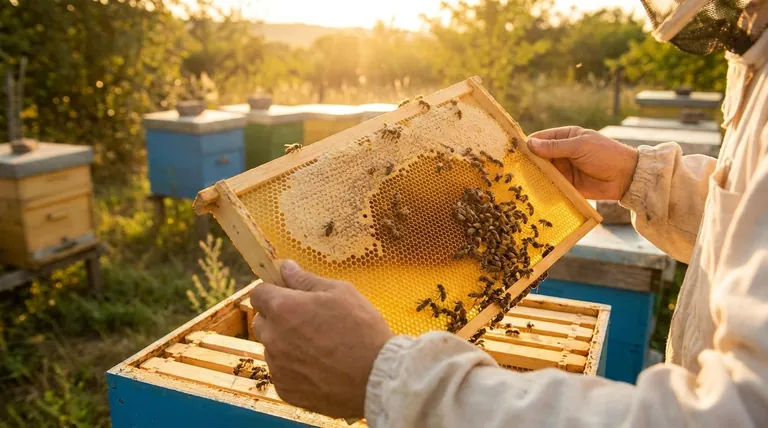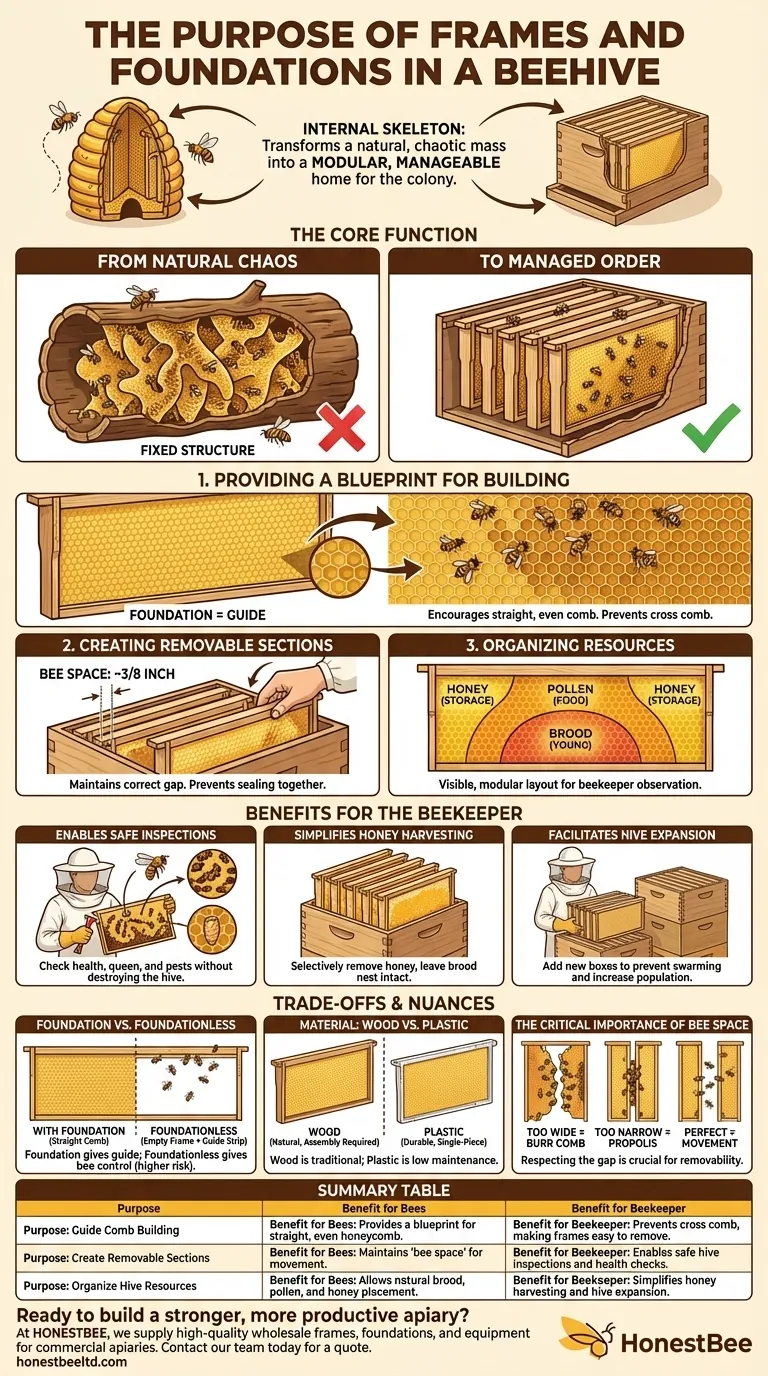At their core, frames and foundations are the internal skeleton of a modern beehive. They provide a structured guide for bees to build their honeycomb, which is used to raise their young (brood) and to store essential food like honey and pollen. This system transforms the hive from a single, inseparable mass of comb into a modular and manageable home for the colony.
The single most important concept to understand is that frames and foundations make the hive manageable for the beekeeper. They turn a chaotic natural structure into an organized system, allowing for inspection, harvesting, and intervention without destroying the colony.

The Core Function: From Natural Chaos to Managed Order
In nature, bees build comb wherever they see fit, often attaching it to the ceiling and walls of a cavity. This creates a fixed, interwoven structure. Frames and foundations were invented to guide this natural instinct into a form that benefits both the bees and the beekeeper.
Providing a Blueprint for Building
A foundation is a thin sheet, typically made of beeswax or plastic, that is imprinted with the hexagonal pattern of honeycomb cells. It is inserted into the frame.
This foundation acts as a guide, encouraging bees to build straight, even comb within the confines of the removable frame. This prevents bees from building "cross comb," where they construct comb across multiple frames, effectively gluing them together.
Creating Removable Sections
The frame's most crucial feature is that it allows each section of comb to be removed individually. The frames hang inside the hive box, carefully spaced to maintain what is known as "bee space."
This specific gap (roughly 3/8 of an inch) is just wide enough for bees to pass through but too narrow for them to build comb in, preventing them from sealing the frames together.
Organizing the Colony's Resources
This modular system allows the beekeeper to observe and influence the colony's natural organization.
Bees instinctively place brood in the warm center of the hive, with a surrounding arch of pollen and then honey on the outer frames. Removable frames make this internal layout visible and easy to manage.
Why This Structure is Essential for the Beekeeper
The ability to remove and inspect individual frames is the cornerstone of modern beekeeping. It provides a window into the colony's health and productivity.
Enabling Safe Hive Inspections
With a framed hive, a beekeeper can gently pull out one frame at a time to assess the colony. This allows them to check for critical signs of health, such as the queen's egg-laying pattern, the presence of pests like Varroa mites, or symptoms of disease.
These inspections can be performed with minimal disturbance and without tearing apart the bees' home and hard work.
Simplifying Honey Harvesting
Frames make honey harvesting efficient and sustainable. The beekeeper can selectively remove only the outer frames that are filled exclusively with capped honey.
This ensures the colony's brood nest and their immediate food stores are left intact, reducing stress on the bees and ensuring their survival.
Facilitating Hive Expansion
As a colony grows, it needs more space. If it runs out of room, its natural instinct is to swarm, where the queen leaves with half the bees to find a new home.
Beekeepers prevent this by adding new boxes with empty frames, giving the colony ample room to expand their population and store more honey. Frames can also be rearranged to encourage the bees to move up into new honey boxes.
Understanding the Trade-offs and Nuances
While the frame and foundation system is the standard, it's important to understand the choices and potential issues involved.
Foundation vs. Foundationless
Some beekeepers prefer foundationless frames, which provide an empty frame with only a small guide strip. This gives bees complete control over the size of the cells they build.
The downside is a higher risk of disorganized, cross comb, especially for new beekeepers. It requires more careful monitoring to ensure the bees build straight.
Material Choices: Wood vs. Plastic
Frames and foundations are available in both wood and plastic. Wood is traditional and natural, but requires assembly and can degrade over time.
Plastic is durable, easy to clean, and often comes as a single-piece frame and foundation unit. Some beekeepers find that bees are slower to draw comb on new plastic foundations.
The Critical Importance of "Bee Space"
The entire system fails if "bee space" is not respected. If frames are too far apart, bees will build extra burr comb in the gaps. If they are too close together, bees will seal the gap with propolis (a resinous "bee glue").
In both cases, the frames become difficult or impossible to remove without breaking the comb and angering the colony.
Making the Right Choice for Your Goal
Mastering the use of frames is central to becoming a successful beekeeper. Your management strategy will depend on the colony's needs at any given time.
- If your primary focus is establishing a new colony: Provide frames with foundation to ensure the bees build straight, manageable comb right from the start.
- If your primary focus is hive health and inspection: Use the removability of frames to conduct regular, gentle checks for the queen, brood pattern, and pests.
- If your primary focus is maximizing honey harvest: Systematically remove only the outer frames that are 100% full of capped honey, leaving the colony with plenty of its own resources.
Ultimately, frames and foundations are the tools that enable a partnership between the bees and the beekeeper.
Summary Table:
| Purpose | Benefit for Bees | Benefit for Beekeeper |
|---|---|---|
| Guide Comb Building | Provides a blueprint for straight, even honeycomb. | Prevents cross comb, making frames easy to remove. |
| Create Removable Sections | Maintains 'bee space' for movement. | Enables safe hive inspections and health checks. |
| Organize Hive Resources | Allows natural brood, pollen, and honey placement. | Simplifies honey harvesting and hive expansion. |
Ready to build a stronger, more productive apiary?
At HONESTBEE, we supply the high-quality frames, foundations, and beekeeping equipment that commercial apiaries and distributors rely on. Our wholesale-focused operations ensure you get the durable, bee-space-perfect components needed for efficient hive management and maximum honey production.
Contact our team today to discuss your supply needs and get a quote.
Visual Guide

Related Products
- Wooden Bee Hive Frames for Beekeeping and Wholesale
- Copper Bee Frame Eyelets for Beekeeping
- Colorful Silicone Beeswax Foundation Mold Mould for Beekeeping
- Heavy-Duty Nylon Beehive Hive Strap with Stainless Steel Cinch Buckle
- Professional Galvanized Hive Strap with Secure Locking Buckle for Beekeeping
People Also Ask
- When should I throw away my bee frames? A Guide to Proactive Hive Health
- Will honey bees clean up old frames? A Guide to Safe and Efficient Frame Reuse
- What are the primary uses of different Langstroth frame sizes? Optimize Your Hive for Health & Honey
- When should bee frames be thrown away? A Beekeeper's Guide to Hive Health & Biosecurity
- What types of beehive frames are compatible with the honey press? A Guide to Crush-and-Strain Extraction



















